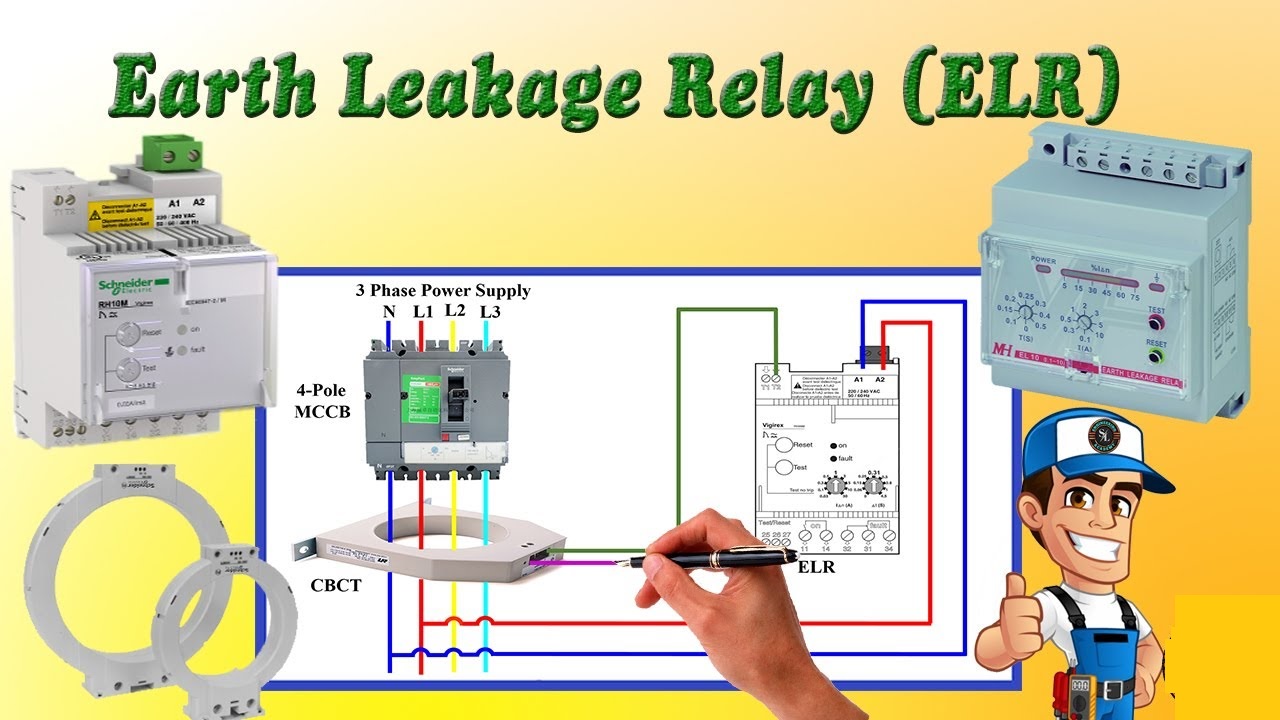Working, Wiring & Testing of CBCT & ELR Relay / Earth fault Relay and CBCT
Welcome to another informative tutorial where we'll guide you on understanding ELR and CBCT. We will also provide step-by-step instructions on how to wire ELR and CBCT in a DOL Starter. Finally, at the end of the video, we will demonstrate how to test ELR and CBCT.
An earth leakage can represent a danger to life or property if it is not located and mitigated. Studies have revealed that at least 500 people experience electrocution every year in the US alone. Earth leakage relays can be helpful in sensing and mitigating such incidents.
What is earth leakage?
Earth leakage is an unindented situation in which a conductor carrying current comes in contact with the earth or chassis of equipment, either directly or indirectly, causing a current flow to the earth. Earth leakages can be a result of insulation failure or electric shock (current flows through the human body to the ground).
What is an earth leakage relay?
An earth leakage relay is a device used to sense earth leakages and open a circuit breaker when the leakage current exceeds the preset value. It can protect human beings from electrocution and prevent fire hazards. Earth leakage relays are used in combination with Core balance current transformers (CBCT) or Zero phase current transformer (ZCT).
Working principle
During an earth fault, the current flows directly to the earth by bypassing the load. This happens when a live conductor touches the earth directly or through the human body. This can be the result of insulation failures, wet surfaces or improper wiring.
Under normal conditions, the vector sum of the current flow in phase and neutral will be zero. Earth faults cause an imbalance in the current flow in the phase and neutral conductors (vector sum of the current would not be zero). Core balance current transformers or zero-phase current transformers are used to sense this current imbalance.
The earth fault relay continuously monitors the output of the CBCT. When its output exceeds the present limit (leakage current limits can be set), the relay contacts operates. These relay contacts are used in the activation of the trip contacts of the circuit breaker and trips it.
ELR Wiring diagram
A typical wiring diagram of an earth leakage relay is shown below. Operational power is applied to the terminal A1 and A2 of the ELR and the CBCT is connected to the terminals T1 and T2. The normally closed terminals of the fault signaling contacts are connected to the Undervoltage release coil of the circuit breaker. So when the leakage current sensed by the CBCT exceeds the set value, the ELR interrupts the power to the undervoltage release and breaker trips immediately.
Earth leakage relays can detect leakage before potential damage is caused. The leakage current limit needs to be adjusted between 10mA and 3A based on the application. IEC/EN 60755 defines general rules for residual-current protection devices.
Working, Wiring & Testing of CBCT & ELR Relay / Earth fault Relay and CBCT
Welcome to another informative tutorial where we'll guide you on understanding ELR and CBCT. We will also provide step-by-step instructions on how to wire ELR and CBCT in a DOL Starter. Finally, at the end of the video, we will demonstrate how to test ELR and CBCT.
An earth leakage can represent a danger to life or property if it is not located and mitigated. Studies have revealed that at least 500 people experience electrocution every year in the US alone. Earth leakage relays can be helpful in sensing and mitigating such incidents.
What is earth leakage?
Earth leakage is an unindented situation in which a conductor carrying current comes in contact with the earth or chassis of equipment, either directly or indirectly, causing a current flow to the earth. Earth leakages can be a result of insulation failure or electric shock (current flows through the human body to the ground).
What is an earth leakage relay?
An earth leakage relay is a device used to sense earth leakages and open a circuit breaker when the leakage current exceeds the preset value. It can protect human beings from electrocution and prevent fire hazards. Earth leakage relays are used in combination with Core balance current transformers (CBCT) or Zero phase current transformer (ZCT).
Working principle
During an earth fault, the current flows directly to the earth by bypassing the load. This happens when a live conductor touches the earth directly or through the human body. This can be the result of insulation failures, wet surfaces or improper wiring.
Under normal conditions, the vector sum of the current flow in phase and neutral will be zero. Earth faults cause an imbalance in the current flow in the phase and neutral conductors (vector sum of the current would not be zero). Core balance current transformers or zero-phase current transformers are used to sense this current imbalance.
The earth fault relay continuously monitors the output of the CBCT. When its output exceeds the present limit (leakage current limits can be set), the relay contacts operates. These relay contacts are used in the activation of the trip contacts of the circuit breaker and trips it.
ELR Wiring diagram
A typical wiring diagram of an earth leakage relay is shown below. Operational power is applied to the terminal A1 and A2 of the ELR and the CBCT is connected to the terminals T1 and T2. The normally closed terminals of the fault signaling contacts are connected to the Undervoltage release coil of the circuit breaker. So when the leakage current sensed by the CBCT exceeds the set value, the ELR interrupts the power to the undervoltage release and breaker trips immediately.
Earth leakage relays can detect leakage before potential damage is caused. The leakage current limit needs to be adjusted between 10mA and 3A based on the application. IEC/EN 60755 defines general rules for residual-current protection devices.






















No comments:
Post a Comment